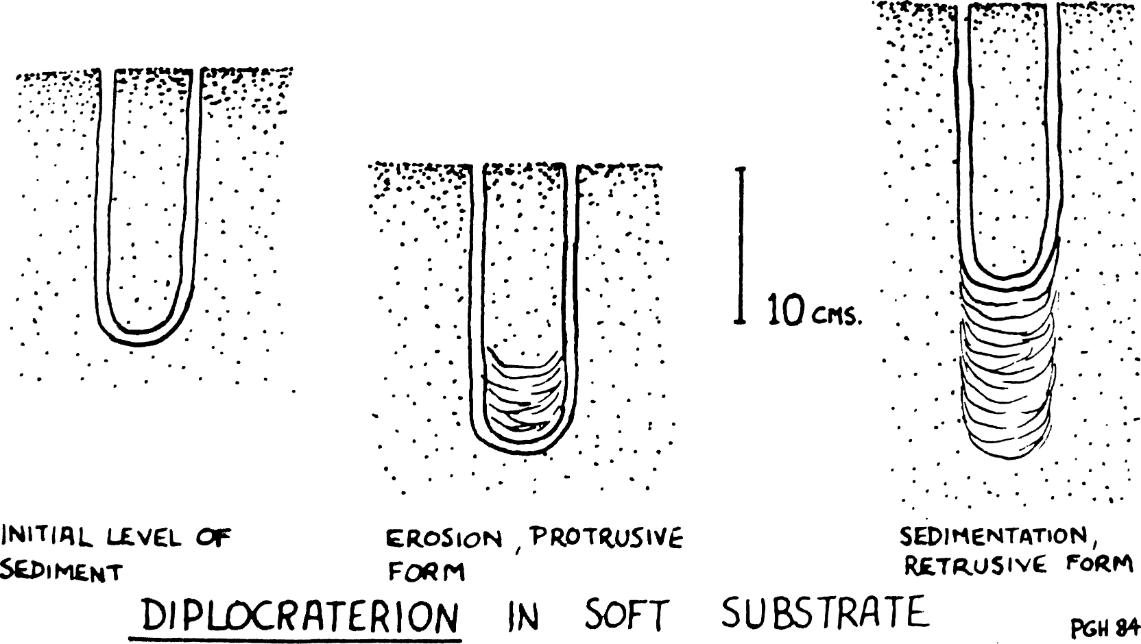Fossils, Boring and Otherwise

If pressed I should be obliged to admit that some fossils can be boring. I would hasten to add however that others are burrowing, or walking or doing a variety of other things. The boring fossils are, of course, limited to that most fascinating group of all, the trace-fossils. It could be, and indeed has been argued that there is no such thing as a boring fossil! You won’t find that undergraduates to agree with this, but I was taken aback (who wouldn’t be when being interviewed by an examiner for the award of their Ph.D?) when I was told that trace-fossils were not sediments at all, but merely deformed sediments! I know a few sedimentologists who might sympathise with this viewpoint too, since trace-fossils do rather spoil their nicely laminated sediments, but I’m glad to be able to write that most sedimentologists today value the trace-fossils which they so frequently encounter, since these are often the best indicators of palaeoenvironment that they can have.
So, if we accept for the moment that we are actually looking at fossils when we see such disturbances in the sedimentary rocks, just what are ‘boring’ fossils. Well, in brief, they are the dwellings of animals which sought shelter from predators or the hostile environment in which they lived, by literally drilling their way into the solid substrate, whether it be a shell, some shell, living or dead, or a piece of driftwood. Such shelters in which animals lived all, or much of their lives, are part of an assemblage of trace-fossils which also includes residential burrows, and which collectively have been given the group name Domichnia. This is only one example of a group of trace-fossils which can be related to one another in terms of the function they represent.
The classification of trace-fossils on any other criteria than their function is rather unsatisfactory since it is animal activity which they represent, and in many cases similar looking products can be made by many different animals whilst performing the same function. Equally the same animal can produce many different trace-fossils by varying its behaviour pattern.
The nomenclature of trace-fossils has arisen, largely accidentally, by comparison of trace-fossils with true body fossils. The latter are named by using the Linnaean binomial system and quite naturally the earliest found trace-fossils which were thought to be fossil sea-weeds by some authors, were similarly given binomial names. This practice has caused not a little confusion, but because of its long history it still continues, largely for want of something better. It is as worry therefore when studying trace-fossils to worry less about what they should be called than about what they can tell us about the environment in which they occur.
Borings in Hard Substrates

Teredo Borings in Wood (Modern)
Diplocraterian in Soft Substrate
One of the great advantages in studying trace-fossils, in comparison with body fossils, is that it is very difficult to imagine a burrow or track being transported and redeposited. Consequently we can be confident that trace-fossils reflect biological activity in situ at, or soon after, the time of deposition of the sediments. This is true of most surface marks and burrows but, as it happens, borings can be and often were made many years - in some cases many millions of years - after the sediment was formed. Consider for a moment the modern beaches around our coasts. You will no doubt have noticed here and there pebbles with curious small (ca. 1mm) dumb-bell like holes in them. These are the modern borings of a minute worm called Polydora which constructs a simple U-tube in which it lives. These tubes penetrate shells and rocks of widely differing ages, but often of great physical strength. You may also have noticed slabs of rock penetrated by large holes, sometimes big enough to accommodate your finger, these perfectly circular, tapering cylindrical borings are made by a variety of bivalves which live permanently trapped inside their borings on the lower part of the shore. The best known example is probably the piddock, Pholas.
These modern examples of marine borings are directly comparable with fossil ones. Those who have seen the famous Mendip unconformity between the middle Jurassic oolitic limestones and the steeply inclined Carboniferous limestone below, will no doubt have observed the borings which penetrate the smooth surface of the Carboniferous limestone from the Jurassic rock above. The difference in age of these two sediments is well over 100 million years and no doubt the bored surface was just as hard then for the Jurassic organisms to penetrate as the Jurassic rock itself would be today.
Other notable drillers in the bivalve group are the infamous ‘shipworms’ better called by their correct generic name of Teredo. These highly modified bivalves are indeed worm-like having reduced their shells to a small pair of blade-like cutters which they apply with vigour to the wood at the end of their ever siphoning tunnel. As with their colleagues the piddocks, the shipworms are obliged to increase the length and width of their tunnels as they grow and so they drill ever wider holes into the substrate and thus appear trapped inside prisons of their own making once fully grown. Normally this would not be a problem for these animals, but it follows that reproduction is of necessity a rather unemotional act for them. Normally this would not be a necessity for these animals, but it follows that reproduction is of necessity a rather unemotional act for them. Normally this would not be a necessity for these animals, but it follows that reproduction is of necessity a rather unemotional act for them. There is however some small danger for the piddocks. Whilst the shipworms go to great lengths to avoid chewing through each others tunnels (is this why they secrete a limey lining to the tunnel in lieu of having proper shells I wonder?) the piddocks on the other hand are quite oblivious to one anothers presence. It is not uncommon for a late arrival on a rock (could it be one of their very own offspring?) to ‘chew’ steadily through the burrows and shells of the previous occupants. So densely crowded are some colonies of piddocks that the rock becomes seriously weakened and takes on the appearance, when broken open, of an “Aero” bar with more holes than sediment.
In addition to borings the other major type of trace-fossil which contributes to the Domichnia is the residential burrow. These are frequently seen on certain bedding planes. They tend to be concentrated at one horizon from which they penetrate down (often but not necessarily, vertically) into the underlying sediment. They are frequently filled with material from the overlying bed and are often of simple structure being either short cylindrical tubes or perhaps U-shaped tubes. Some are oblique or horizontal below the surface but only rarely do true dwelling burrows ramify through the sediment in a system of tunnels.
Perhaps the commonest form of simple dwelling burrow is the ubiquitous U-tube Diplocraterion. This is a vertical structure which was maintained as an open tube in the animals life-time and which was kept at an optimum depth below the sediment/water interface. The animal (which was anarthropod - known from rare finds in the burrow) was able to extend the tube downwards by removing the deposits at the bottom and packing them into the roof if sediment was being eroded from above. Conversely, if deposition was occurring, then the animal could cut away the deposits above the U and pack them into the floor. This movement leaves traces in the sediment discernable as a series of curving striations which are parallel with the U-tube itself and go by the name of spreite. This rare ability of the animal to move its burrow base up or down at will gave rise to the highly appropriate and thoroughly laudable specific name of yoyo which the fossil has.
Now, as to the significance of borings and burrows in interpreting the palaeo-environment, there are a number of things which can be stated plainly. For example, if a smooth erosion surface is found without borings then it could be that the overlying sediment was deposited immediately after the erosion, but equally there could be a significant time-break between the two horizons. If borings are present however we can be confident that, at least for the duration of one animal’s life-time, there was no significant deposition of sediment, otherwise the trapped borers would have been smothered. If, as happens in the example of the Mendip Jurassic/Carboniferous unconformity, we can see several generations of borings, then we can argue that there must have been a time interval of several generations in length without significant sedimentation. (This may seem a trivial distinction but see later how it compares with the case of the burrows). If, as also seen in the Mendip, there are borings which are now cut off by further erosion since they were initiated, we can also state that the erosion which produced the final surface was still proceeding in Jurassic times. This implies a slow and drawnout period of live process times. There was as little, there was no instant inundation, transgression by the Jurassic sea.
Consider now the burrows. These could be made in sediment of varying firmness but clearly could not be made in lithified material. They must have been made when the animal was capable of reaching the water above the sediment, and yet in the case of some units of rock, where we have evidence of upward moving burrows, the implication is that the sediment was still being deposited during the animal’s lifetime. In fact we can confidently say that the vertical thickness of sediment an upward-moving burrow whatever, so much must have been deposited during the animal’s lifetime. Since this type of upward-moving (retrusive) burrow is quite a common form in various horizons e.g. Lower Carboniferous limestones, Upper Carboniferous sandstones and Jurassic oolites quite a convincing inferably obvious that many of the clastic sedimentary rocks we see were deposited very rapidly indeed.
To date, the highest (not deepest) note, but highest, these animals were moving up!) such that that I have come across was some 2 metres. The clayey tracers that the rate of sediment (assuming no compaction) was deposited in a space of time less than the lifetime of the animal. In this case the animal was a very small bivalve living in the Upper Carboniferous tropical swamps and shows no signs of growth during ascent, so we can confidently assume a period of a few years at most and in all probability a period well under one year. In fact most retrusive forms are of much more modest height and a figure of 20-50 cms would be more typical. These rapid rates of accumulation contrast markedly with the periods of several years with no sediment accumulation at all which are indicated by the presence of borings.
To summarise then, where we find borings penetrating a hard surface we can reasonably assume a time-gap which may be demonstrably of some years in duration. Where, on the other hand we see dwelling-burrows, we can demonstrate in some cases that the sediments were being eroded rapidly and forced relatively short-lived animals to burrow deeper, in other cases we can see that sediment was being deposited, and in some of these we can see evidence for the rapid accumulation of considerable thicknesses of clastic rocks.
In conclusion may I ask two things of you? a. Look out for trace-fossils and appreciate them for the fascinating and valuable clues they are, and b. please do let me know if you find any interesting sites with examples of retrusive dwelling burrows or other trace-fossils.



